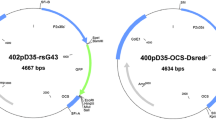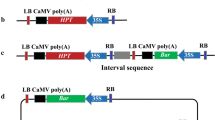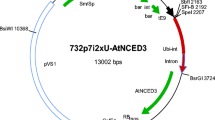Abstract
Genetic transformation of an elite white poplar genotype (Populus alba L., cv. ‘Villafranca’) was performed with MAT vectors carrying the ipt and rol genes from Agrobacterium spp. as morphological markers. The effects associated with the use of different gene promoters and distinct in vitro regeneration protocols were evaluated. Poplar plantlets showing abnormal ipt and rol phenotypes were produced only in the presence of exogenous growth regulators. The occurrence of abnormal ipt and rol phenotypes allowed the visual selection of transformants. The ipt-type MAT vector pEXM2 was used to monitor the activity of the yeast site-specific recombination R/RS system in the transformed white poplar cells. Results from these experiments demonstrated that recombinase-mediated excision events occurred during the early stages of in vitro culture, thus causing the direct production of ipt marker-free transgenic plants with normal phenotype at an estimated frequency of 36.4%. Beside this unexpected finding, transgenic ipt-shooty plants were obtained at a frequency of 63.6% and normal shoots were subsequently recovered after a prolonged period of in vitro culture. Although the transformation efficiency observed in this study, using both ipt and nptII genes as selection markers, was similar to that previously reported with standard vectors carrying only the nptII gene, the easy identification of ipt transformants, the early recombinase-mediated excision events and finally the relatively short time period required to produce ipt marker-free transgenic plants support for the choice of MAT vectors as a reliable strategy for the future production of marker-free GM poplars.





Similar content being viewed by others
Abbreviations
- BAP:
-
Benzyl-aminopurine
- NAA:
-
α-Naphthaleneacetic acid
- TDZ:
-
Thidiazuron
References
Araki H, Jearnpipatkula A, Tatsumi H, Sakurai T, Ushino K, Muta T, Oshima Y (1987) Molecular and functional organization of yeast plasmid pSR1. J Mol Biol 182:191–203
Balestrazzi A, Carbonera D, Confalonieri M (2000) Agrobacterium tumefaciens-mediated transformation of elite white poplar (Populus alba L.) and regeneration of transgenic plants. J Genet Breed 54:263–267
Balestrazzi A, Allegro G., Confalonieri M (2006) Genetically modified trees expressing genes for insect pest resistance. In: Fladung M, Ewald D (eds) Tree transgenesis: recent developments. Springer-Verlag Berlin Heidelberg, pp 253–273
Ballester A, Cervera M, Pena L (2006) Efficient production of transgenic citrus plants using isopentenyl transferase positive selection and removal of the marker gene by site-specific recombination. Plant Cell Rep, DOI 10.1007/s00299-006-0197-3
Confalonieri M, Balestrazzi A, Bisoffi S (1994) Genetic transformation of Populus nigra by Agrobacterium tumefaciens. Plant Cell Rep 13:256–261
Confalonieri M, Belenghi B, Balestrazzi A, Negri S, Facciotto G, Schenone G, Delledonne M (2000) Transformation of elite white poplar (Populus alba L.) cv. ‘Villafranca’ and evaluation of herbicide resistance. Plant Cell Rep 19:978–982
Cui M, Takayanagi K, Kamada H, Nishimura S, Handa T (2000) Transformation of Antirrhinum majus L. by a rol-type multi-auto-transformation (MAT) vector system. Plant Sci 159:273–280
Cui M, Takayanagi K, Kamada H, Nishimura S, Handa T (2001) Efficient shoot regeneration from hairy roots of Antirrhinum majus L. transformed by the rol-type MAT vector system. Plant Cell Rep 20:55–59
Delledonne M, Allegro G, Belenghi B, Balestrazzi A, Picco F, Levine A, Zelasco S, Calligari P, Confalonieri M (2001) Transformation of white poplar (Populus alba L.) with a novel Arabidopsis thaliana cysteine proteinase inhibitor and analysis of insect pest resistance. Mol Breed 7:35–42
Ebinuma H, Sugita K, Matsunaga E, Yamakado M (1997) Selection of marker-free transgenic plants using the isopenthenyl transferase gene. Proc Natl Acad Sci USA 94:2117–2121
Ebinuma H, Komamine A (2001) MAT (Multi-Auto-Transformation) vector system. The oncogenes of Agrobacterium as positive markers for regeneration and selection of marker-free transgenic plants. In Vitro Cell Dev Biol-Plant 37:103–113
Endo S, Sugita K, Sakai M, Tanaka H, Ebinuma H (2002) Single-step transformation for generating marker-free transgenic rice using the ipt-type MAT vector system. Plant J 30:115–122
Fladung M, Kumar S, Ahuja MR (1997) Genetic transformation of Populus genotypes with different chimeric gene constructs: transformation efficiency and molecular analysis. Trans Res 6:111–121
Giorcelli A, Sparvoli F, Mattivi F, Balestrazzi A, Tava A, Vrhovsek U, Calligari P, Bollini R, Confalonieri M (2004) Expression of the stilbene synthase (StSy) gene from grapevine in transgenic white poplar results in high accumulation of the antioxidant compounds resveratrol glucosides. Trans Res 13:203–214
Goldstein DA, Tinland B, Gilbertson LA, Staub JM, Bannon GA, Goodman RE, Mc Coy RL, Silvanovich A (2005). Human safety and genetically modified plants: a review of antibiotic resistance markers and future transformation selection technologies. J Appl Microbiol 99:7–23
Hohn B, Levy A, Putcha H (2001) Elimination of selection markers from transgenic plants. Curr Opin Biotech 12:139–143
Hood EE, Gelvin SB, Melchers LS, Hoekema A (1993) New Agrobacteria helper plasmids for gene transfer to plants. Trans Res 2:208–218
Khan RS, Chin DP, Nakamura I, Mii M (2006) Production of marker-free transgenic Nierembergia caerulea using MAT vector system, Plant Cell Rep, DOI 10.1007/s00299-006-0125-6
Matsunaga E, Sugita K, Ebinuma H (2002) Asexual production of selectable-marker free transgenic woody plants, vegetatively propagated species. Mol Breed 10:95–106
Murashige T, Skoog F (1962) A revised medium for rapid growth and bioassays with tobacco tissue cultures. Physiol Plant 15:73–97
Nilsson O, Moritz T, Sundberg B, Sandberg G, Olsson O (1996) Expression of the Agrobacterium rhizogenes rolC gene in a deciduous forest tree alters growth and development and leads to stem fasciation. Plant Physiol 112:493–502
Otha S, Mita S, Hattori T, Nakamura K (1990) Construction and expression in tobacco of a β-glucuronidase (GUS) reporter gene containing an intron within the coding sequence. Plant Cell Physiol 3:805–813
Rogers SO, Bendich AJ (1988) Extraction of DNA from plant tissues. In: Gelvin SB, Schilperoort RA (eds) Plant molecular biology manual, A6. Kluwer, Dordrecht, pp 1–10
Sambrook J, Fritsch EF, Maniatis T (1989) Molecular cloning: a laboratory manual. Cold Spring Harbor Laboratory Press, Cold Spring Harbor, New York
Sugita K, Matsunaga E, Ebinuma H (1999) Effective selection system for generating marker-free transgenic plants independent of sexual crossing. Plant Cell Rep 18:941–947
Sugita K, Matsunaga E, Kasahara T, Ebinuma M. (2000) Transgene stacking in plants in the absence of sexual crossing. Mol Breed 6:529–536
Tzfira T, Zuker A, Altman A (1998) Forest-tree biotechnology: genetic transformation and its application to future forests. Trends Biotech 16:439–446
Vancanneyet G, Schmidt R, O’Connor-Sanchez A, Willmitzer L, Rocha-Sosa M (1990) Construction of an intron-containing marker gene: splicing of the intron in transgenic plants and its use in monitoring early events in Agrobacterium-mediated plant transformation. Mol Gen Genet 220:245–250
Von Schwartzenberg K, Doumas P, Jouanin L, Pilate G (1994) Enhancement of the endogenous cytokinin concentration in poplar by transformation with Agrobacterium T-DNA gene ipt. Tree Physiol 14:27–35
Zelasco S, Fogher C, Calligari P, Savazzini F, Bisoffi S, Pietra S, Bolchi A, Scaramelli L, Ottonello S, Confalonieri M (2004) Expression of an artificial metallothionein gene in transgenic white poplar and evaluation of cadmium tolerance. Proceedings of SIFV—SIGA Joint Congress. SIFV XLIII Annual Congress—SIGA XLVIII Annual Congress. Lecce, 15–18 September 2004, p. 223
Zelasco S, Reggi S, Calligari P, Balestrazzi A, Bongiorni C, Quattrini E, Delia G, Bisoffi S, Fogher C, Confalonieri M (2006) Expression of the Vitreoscilla hemoglobin (VHb)-encoding gene in transgenic white poplar: plant growth and biomass production, biochemical characterization and cell survival under submergence, oxidative and nitrosative stress conditions. Mol Breed 17:201–216
Zuo J, Niu Q-W, Ikeda Y, Chua N-H (2002) Marker-free transformation: increasing transformation frequency by the use of regeneration-promoting genes. Curr Opin Biotech 13:173–180
Acknowledgments
This research was supported by a grant from ‘Ministero dell’Università e della Ricerca Scientifica’ (COFIN 2003) and by a grant from Fondazione Branca-Bussolera. S. Z. and V. R. were awarded by a Research Fellowship from Fondazione Branca-Bussolera, Mairano di Casteggio (Italy). We would like to thank Tiziano Collot for excellent technical assistance.
Author information
Authors and Affiliations
Corresponding author
Rights and permissions
About this article
Cite this article
Zelasco, S., Ressegotti, V., Confalonieri, M. et al. Evaluation of MAT-vector system in white poplar (Populus alba L.) and production of ipt marker-free transgenic plants by ‘single-step transformation’. Plant Cell Tiss Organ Cult 91, 61–72 (2007). https://doi.org/10.1007/s11240-007-9278-4
Received:
Accepted:
Published:
Issue Date:
DOI: https://doi.org/10.1007/s11240-007-9278-4




